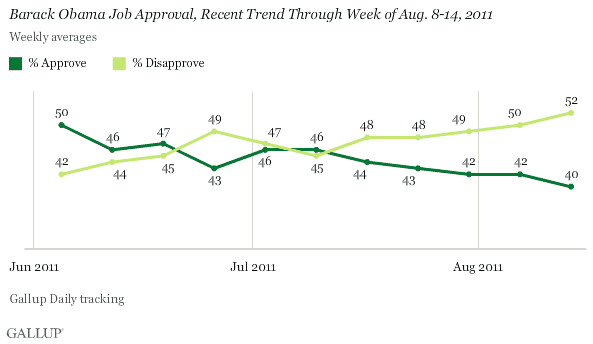PRINCETON, NJ -- President Obama's job approval rating dropped to 40% during the week spanning Aug. 8-14, the lowest weekly average of his administration. During this period, Obama's three-day rolling average also hit a new low of 39% for Aug. 11-13, the first such average below 40% since he took office, though it recovered to 41% for Aug. 12-14.

Obama's weekly average was 42% for the two weeks prior to last week, which at that time also marked new lows for his administration. His lowest three-day average prior to Aug. 11-13 had been 40%.
With the exception of a dramatic national or international event, it is usually difficult to pinpoint the causes for the short-term ups and downs in a president's job ratings. In the current situation, it is reasonable to assume that several events of the last few weeks have played a part in depressing the public's approval of Obama. These include the widespread public disapproval of the way Washington handled the debt crisis, a substantial drop in the public's confidence in the economy, and last week's gyrations in the stock market.
Additionally, there was substantial news coverage of the Republican presidential candidate debate and the Ames Straw Poll in Iowa at the end of last week, including harsh criticism of Obama from all of the Republican contenders.
Implications
Although the new lows in Obama's job approval rating represent only a slight drop from his previous low readings, they symbolically underscore the weaker position the president is in as he begins a "listening tour" of the Midwest this week.
Ten incumbent presidents have sought re-election since World War II, and none has won a second term with final pre-election job approval ratings below 48%. The last two presidents who lost their re-election bids -- George H.W. Bush and Jimmy Carter -- had job approval ratings in the 30% range in the fall of the election year. Thus, Obama's challenge is not only to move his rating back above 40%, but also to push it close to or above 50%.
The crucial period for Obama will begin after Labor Day, given the relative quiet on the political front that should be the case before then. Obama will generate some news coverage this week with his bus tour through Minnesota, Iowa, and Illinois, but after that, he has a scheduled vacation on Martha's Vineyard, during which he will be largely out of the news -- barring some major crisis. Republican candidates will continue campaigning over the next several weeks, but with no major debates or other events scheduled until September, they too will not be generating as much news as they have during the past week.
September will bring more GOP debates and an increasing focus on the budget situation, as the new congressional "supercommittee" begins its work and as Congress and Obama return to Washington. If the president is not able to turn around the negative momentum in his ratings during the fall months, it may be more and more difficult for him to do so as the presidential campaign begins in earnest next year.
Explore President Obama's approval ratings in depth and compare them with those of past presidents in the Gallup Presidential Job Approval Center.
Survey Methods
Results are based on telephone interviews conducted as part of Gallup Daily tracking Aug. 8-14, 2011, with a random sample of 3,583 national adults, aged 18 and older, living in all 50 U.S. states and the District of Columbia.
For results based on the total sample of national adults, one can say with 95% confidence that the maximum margin of sampling error is ±2 percentage points.
Interviews are conducted with respondents on landline telephones and cellular phones, with interviews conducted in Spanish for respondents who are primarily Spanish-speaking. Each sample includes a minimum quota of 400 cell phone respondents and 600 landline respondents per 1,000 national adults, with additional minimum quotas among landline respondents by region. Landline telephone numbers are chosen at random among listed telephone numbers. Cell phone numbers are selected using random-digit-dial methods. Landline respondents are chosen at random within each household on the basis of which member had the most recent birthday.
Samples are weighted by gender, age, race, Hispanic ethnicity, education, region, adults in the household, and phone status (cell phone only/landline only/both, cell phone mostly, and having an unlisted landline number). Demographic weighting targets are based on the March 2010 Current Population Survey figures for the aged 18 and older non-institutionalized population living in U.S. telephone households. All reported margins of sampling error include the computed design effects for weighting and sample design.
In addition to sampling error, question wording and practical difficulties in conducting surveys can introduce error or bias into the findings of public opinion polls.
For more details on Gallup's polling methodology, visit www.gallup.com.
